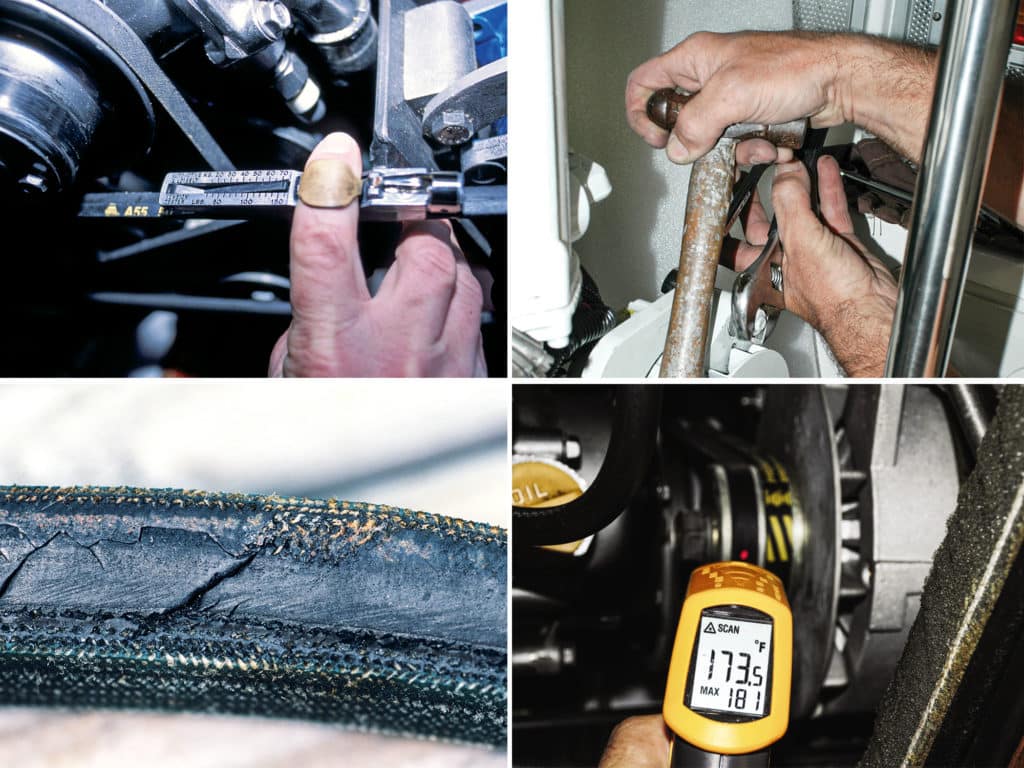
It’s a sound that will make any gearhead cringe: the high-pitched squeal of a slipping fan belt. Well, more accurately, because marine engines have no fans, it’s an “accessory drive” belt, and that awful noise usually happens at startup (more on that in a moment). When belts do this, they’re sending out an SOS that must be addressed.
Typical belts on a sailboat’s auxiliary engine provide motive force to circulator pumps, which pump coolant; raw water pumps, which pump seawater; and alternators. Sometimes, they also might be used for operating a fridge compressor.
That noisy slippage can occur for a few reasons, the most common being improper tension, but that’s only part of the story. If a belt slips because tension is inadequate, another phenomenon comes into play, called glazing. As the belt slips, it quickly generates heat, which causes the belt material to melt and then cool, which in turn leads to plasticization. In other words, the belt becomes hard and brittle, and will often crack. If glazing occurs, no amount of retensioning will resolve the issue; the damage has been done.
But wait, it gets worse. Not only is the belt damaged by slippage, the pulley walls also might be affected; they too can become glazed and take on an appearance that resembles polished stainless steel or chrome, a surface that is extremely slippery. When encountering a damaged belt, or one broken altogether by slippage, the first reaction of most users is simply to replace it. However, that will usually lead to a repeat performance if the pulley too is glazed. In that case, additional remediation is required; the pulley’s glazed drive surfaces must be reconditioned by sanding with 220-grit emery paper, converting the polished surface into one that is duller or satinlike, which will better allow the belt to gain traction.
RELATED: Engine Cooling System Maintenance
There’s more: A chronically slipping alternator belt can generate enough heat in the pulley (which will travel down the alternator’s drive shaft to the rotor) to upset the magnetic field within, which can drive the alternator’s output to zero. I’ve encountered non-functioning alternators whose pulleys had turned purple from overheating.
Attaining proper belt tension often presents a challenge for both boat owners and seasoned professionals alike. The common “quarter-inch of deflection for every foot of belt span” rule of thumb is flawed in that the tension is undefined: Lean into it hard enough, and you can get it to deflect a lot more than a quarter-inch, regardless of how tight it might be. I find that pros tend to over tighten belts (which can lead to circulator-pump and alternator-bearing failure), while the average boat owner tends to under tighten them, which leads to the aforementioned slippage. Ideally, the goal should be to tighten a belt just enough to prevent slippage, and no more. If you are unsure, use a belt-tension measurement tool such as a Gates Krikit gauge.
The squeal-on-startup phenomenon occurs usually as a result of alternator load. As soon as the engine starts, the alternator begins charging the battery, replacing power that’s been used by onboard gear as well as the starter itself; it briefly might go to “full field,” producing maximum output, which in turn places a high load on the belt, causing it to slip if undertensioned. Adding to this issue is the fact that most alternator pulleys are small in diameter, which allows higher alternator rpm, and thus higher output, even when engine rpm is comparatively low. This necessary evil means that the belt-to-pulley contact area is smaller, which places greater emphasis on proper tension to prevent slippage. Larger pulleys, such as those often used for raw-water pumps, turn slower. And because of their greater contact area, they rarely slip, even if undertensioned.
Next month, I’ll discuss serpentine belts, including belt alignment, selection and replacement.
Steve D’Antonio offers services for boat owners and buyers through Steve D’Antonio Marine Consulting.








